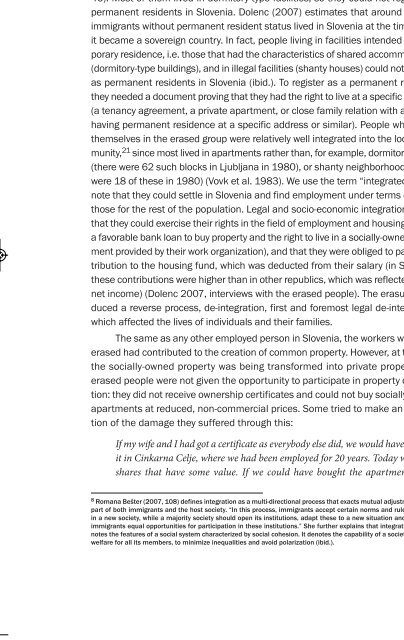The Scars of the Erasure_web
The Scars of the Erasure_web
The Scars of the Erasure_web
- No tags were found...
Create successful ePaper yourself
Turn your PDF publications into a flip-book with our unique Google optimized e-Paper software.
<strong>Erasure</strong>_4a 10.1.11 20:29 Page 2626 THE SCARS OF THE ERASUREareas. According to <strong>the</strong> Inter-Municipal Community for Employment, <strong>the</strong> majority<strong>of</strong> immigrants found jobs in industry and construction work (Gulič 1983, 40). Forexample, <strong>the</strong> construction sector was directly dependent on immigrants, given that<strong>the</strong>y accounted for 70 percent <strong>of</strong> <strong>the</strong> total number <strong>of</strong> construction workers (ibid.,46). Most <strong>of</strong> <strong>the</strong>m lived in dormitory-type facilities, so <strong>the</strong>y could not register aspermanent residents in Slovenia. Dolenc (2007) estimates that around 30,000immigrants without permanent resident status lived in Slovenia at <strong>the</strong> time whenit became a sovereign country. In fact, people living in facilities intended for temporaryresidence, i.e. those that had <strong>the</strong> characteristics <strong>of</strong> shared accommodation(dormitory-type buildings), and in illegal facilities (shanty houses) could not registeras permanent residents in Slovenia (ibid.). To register as a permanent resident,<strong>the</strong>y needed a document proving that <strong>the</strong>y had <strong>the</strong> right to live at a specific address(a tenancy agreement, a private apartment, or close family relation with a personhaving permanent residence at a specific address or similar). People who found<strong>the</strong>mselves in <strong>the</strong> erased group were relatively well integrated into <strong>the</strong> local community,21 since most lived in apartments ra<strong>the</strong>r than, for example, dormitory blocks(<strong>the</strong>re were 62 such blocks in Ljubljana in 1980), or shanty neighborhoods (<strong>the</strong>rewere 18 <strong>of</strong> <strong>the</strong>se in 1980) (Vovk et al. 1983). We use <strong>the</strong> term “integrated” to denotethat <strong>the</strong>y could settle in Slovenia and find employment under terms equal tothose for <strong>the</strong> rest <strong>of</strong> <strong>the</strong> population. Legal and socio-economic integration meantthat <strong>the</strong>y could exercise <strong>the</strong>ir rights in <strong>the</strong> field <strong>of</strong> employment and housing (obtaina favorable bank loan to buy property and <strong>the</strong> right to live in a socially-owned apartmentprovided by <strong>the</strong>ir work organization), and that <strong>the</strong>y were obliged to pay a contributionto <strong>the</strong> housing fund, which was deducted from <strong>the</strong>ir salary (in Slovenia,<strong>the</strong>se contributions were higher than in o<strong>the</strong>r republics, which was reflected in <strong>the</strong>net income) (Dolenc 2007, interviews with <strong>the</strong> erased people). <strong>The</strong> erasure introduceda reverse process, de-integration, first and foremost legal de-integration,which affected <strong>the</strong> lives <strong>of</strong> individuals and <strong>the</strong>ir families.<strong>The</strong> same as any o<strong>the</strong>r employed person in Slovenia, <strong>the</strong> workers who wereerased had contributed to <strong>the</strong> creation <strong>of</strong> common property. However, at <strong>the</strong> time<strong>the</strong> socially-owned property was being transformed into private property, <strong>the</strong>erased people were not given <strong>the</strong> opportunity to participate in property distribution:<strong>the</strong>y did not receive ownership certificates and could not buy socially ownedapartments at reduced, non-commercial prices. Some tried to make an estimation<strong>of</strong> <strong>the</strong> damage <strong>the</strong>y suffered through this:If my wife and I had got a certificate as everybody else did, we would have investedit in Cinkarna Celje, where we had been employed for 20 years. Today we’d haveshares that have some value. If we could have bought <strong>the</strong> apartment under8 Romana Bešter (2007, 108) defines integration as a multi-directional process that exacts mutual adjustment on <strong>the</strong>part <strong>of</strong> both immigrants and <strong>the</strong> host society. “In this process, immigrants accept certain norms and rules observedin a new society, while a majority society should open its institutions, adapt <strong>the</strong>se to a new situation and ensure forimmigrants equal opportunities for participation in <strong>the</strong>se institutions.” She fur<strong>the</strong>r explains that integration also denotes<strong>the</strong> features <strong>of</strong> a social system characterized by social cohesion. It denotes <strong>the</strong> capability <strong>of</strong> a society to ensurewelfare for all its members, to minimize inequalities and avoid polarization (ibid.).


